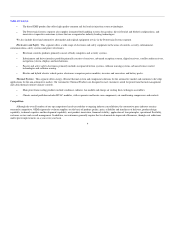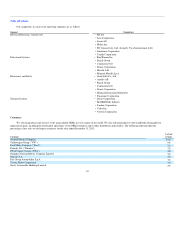DELPHI 2011 Annual Report Download - page 20
Download and view the complete annual report
Please find page 20 of the 2011 DELPHI annual report below. You can navigate through the pages in the report by either clicking on the pages listed below, or by using the keyword search tool below to find specific information within the annual report.
Table of Contents
have a material adverse effect on us. To the extent that we do not maintain our existing level of business with our largest customers because of a decline in
their production requirements or because the contracts expire or are terminated for convenience, we will need to attract new customers or win new business
with existing customers, or our results of operations and financial condition will be adversely affected. See Item 1. Supply Relationships with Our Customers
for a detailed discussion of our supply agreements with our customers.
We have invested substantial resources in markets where we expect growth and we may be unable to timely alter our strategies should such
expectations not be realized.
Our future growth is dependent on our making the right investments at the right time to support product development and manufacturing capacity in
areas where we can support our customer base. We have identified the Asia Pacific and South American regions, and China, Brazil and India, in particular, as
key markets likely to experience substantial growth, and accordingly have made and expect to continue to make substantial investments, both directly and
through participation in various partnerships and joint ventures, in numerous manufacturing operations, technical centers and other infrastructure to support
anticipated growth in those regions. If we are unable to deepen existing and develop additional customer relationships in these regions, we may not only fail to
realize expected rates of return on our existing investments, but we may incur losses on such investments and be unable to timely redeploy the invested capital
to take advantage of other markets, potentially resulting in lost market share to our competitors. Our results will also suffer if these regions do not grow as
quickly as we anticipate.
Our business in China is subject to aggressive competition and is sensitive to economic and market conditions.
Maintaining a strong position in the Chinese market is a key component of our global growth strategy. The automotive supply market in China is highly
competitive, with competition from many of the largest global manufacturers and numerous smaller domestic manufacturers. As the size of the Chinese
market continues to increase, we anticipate that additional competitors, both international and domestic, will seek to enter the Chinese market and that existing
market participants will act aggressively to increase their market share. Increased competition may result in price reductions, reduced margins and our
inability to gain or hold market share. In addition, our business in China is sensitive to economic and market conditions that drive sales volume in China. If
we are unable to maintain our position in the Chinese market or if vehicle sales in China decrease or do not continue to increase, our business and financial
results could be materially adversely affected.
Disruptions in the supply of raw materials and other supplies that we and our customers use in our products may adversely affect our profitability.
We and our customers use a broad range of materials and supplies, including copper, aluminum and other metals, petroleum-based resins, chemicals,
electronic components and semiconductors. A significant disruption in the supply of these materials for any reason could decrease our production and
shipping levels, which could materially increase our operating costs and materially decrease our profit margins.
We, as with other component manufacturers in the automotive industry, ship products to our customers' vehicle assembly plants throughout the world
so they are delivered on a "just-in-time" basis in order to maintain low inventory levels. Our suppliers also use a similar method. However, this "just-in-time"
method makes the logistics supply chain in our industry very complex and very vulnerable to disruptions.
Such disruptions could be caused by any one of a myriad of potential problems, such as closures of one of our or our suppliers' plants or critical
manufacturing lines due to strikes, mechanical breakdowns, electrical outages, fires, explosions or political upheaval, as well as logistical complications due
to weather, volcanic eruptions, or other natural or nuclear disasters, mechanical failures, delayed customs processing and more. Additionally, as we grow in
low cost countries, the risk for such disruptions is heightened. The lack of even a
19
























